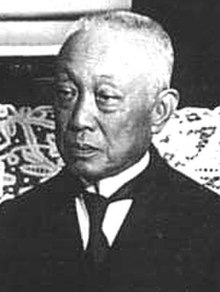Saionji Kimmochi
Kōshaku Saionji Kimmochi ( Japanese 西 園 寺 公 望 ; * December 7, 1849 in Kyoto ; † November 24, 1940 in Okitsu , Ihara County (today: Shimizu-ku , Shizuoka ), Shizuoka Prefecture , Japan ) was a Japanese statesman who was 12 and 14th Prime Minister of Japan and the last Genrō .
biography
The descendant of the noble family ( Kuge ) Tokudaiji was adopted by the Saionji family after the death of his parents in 1852 . In 1868 he was a member of the movement that led to the restoration of imperial rule under the Meiji-Tennō . During the Restoration, he became governor of Echigo Prefecture ; he held the position until 1869, when the prefecture was merged with the former Niigata prefecture to form Suibara Prefecture (now Niigata Prefecture ). In 1869 he founded the Ritsumeikan private school (Shijuku Ritsumeikan), from which today's Ritsumeikan University emerged . From 1870 he studied law at the Sorbonne . In 1881 he was the founder of the Tōyō Jiyū Shimbun (Oriental Free Press), a newspaper that was devoted to the popularization of democratic ideas.
However, since journalism was not considered a worthy profession for a court noble at that time , other nobles at the Tennō prevailed to appoint him to the government service, in which he held several high positions in the subsequent period. In 1884 he was appointed Kōshaku ( margrave ), in 1890 a member of the manor house . From June 1887 to July 1891 he was authorized envoy to the German Empire . From 1894 to 1896 he was minister of education in the Itō and Matsukata cabinets, and from May to September 1896 he was also foreign minister .
As chairman of the State Council (1900-1903) he was temporarily from May 10 to June 2, 1901 also acting Prime Minister. At that time he was also acting finance minister .
He also became one of the leading figures and finally in 1903 President of the Rikken Seiyūkai (Friends of the Constitutional Government), the most important political party of the time. From January 7, 1906 to July 14, 1908 he was Prime Minister of Japan .
On August 30, 1911 he was again prime minister and tried in this position to cut the military budget and also to push party politics to control the governments. This led to the resignation of Army Minister Ishimoto Shinroku and triggered a political crisis in the subsequent Taishō period . On December 21, 1912, however, he resigned from his post as Prime Minister and also resigned from his post as President of the Rikken Seiyūkai. He was succeeded by Katsura Tarō , whom he had followed in office in 1906 and 1911.
Prime Minister Hara Takashi appointed him head of the Japanese delegation to the 1919 Paris Peace Conference , which had the aim of establishing peace conditions after the end of the First World War . For his services he was ennobled in 1922 by Taishō-Tennō ( Yoshihito ) to Kōshaku ( Duke / Prince ).
He spent the last years of his life as a retired statesman (Genrō), a title reserved for an exclusive group of leaders in high government positions of the Meiji era who proposed candidates for nomination to the Tennō in particular as prime ministers. After Matsukata Masayoshi's death in 1924, Saionji was the only genrō and thus nominated the heads of government of the empire alone until his death in 1940. He also recommended Kido Kōichi in 1933 as chairman of the department of the Imperial Court Office , which deals with questions of the imperial family, imperial conferences, etc. ( Kunai-shō Sōchitsu-ryō ).
Because of his efforts to temper ultra-nationalist and militarist tendencies prior to World War II , right-wing fanaticists attempted to assassinate him in the 1930s, as in the attempted coup of February 26, 1936 .
In 1940 he died as the last genrō in Okitsu, where he had owned the Zagyosō summer house since 1919 .
Web links
- rulers.org
- National Parliamentary Library , Archives on Japanese Modernists: Saionji Kimmochi (Japanese, English )
- Newspaper article about Saionji Kimmochi in the press kit of the 20th century of the ZBW - Leibniz Information Center for Economics .
| personal data | |
|---|---|
| SURNAME | Saionji Kimmochi |
| ALTERNATIVE NAMES | Saionji Kinmochi; 西 園 寺 公 望 (Japanese) |
| BRIEF DESCRIPTION | 12th and 14th Prime Ministers of Japan |
| DATE OF BIRTH | December 7, 1849 |
| PLACE OF BIRTH | Kyoto |
| DATE OF DEATH | November 24, 1940 |
| Place of death | Okitsu , Ihara County |
